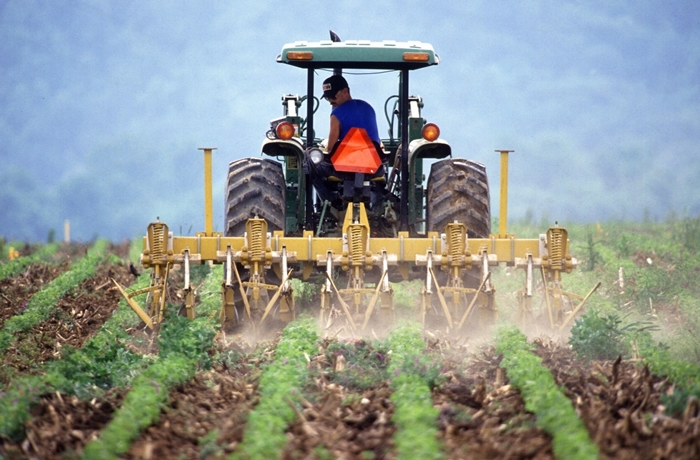The Asia Plus news agency of Tajikistan recently had a conversation with Dr. Yarash Pulatov, a professor at the Institute of Water Problems, Hydropower and Ecology of the Academy of Sciences.
For more than 25 years, Dr. Pulatov and his team have conducted research on the use of water-saving technologies. As a result, they outlined more than 20 water saving methods in the agricultural sector of Tajikistan.
If farmers put them into practice, they will receive maximum income due to increased crop yields and saving water and fertilizers. But to do this, you need to find investments in the amount of $5 thousand and above for the installation of water-saving technologies with a full payback period of 6 years and above.
Why is it necessary to conserve irrigation water?
Given the limited volume of water resources in the Central Asian region (average annual surface river flow is 115.6 km3), water deficit increases annually with increasing load on them.
This situation requires a radical change in views and attitudes towards water as the basis of life and the main factor of peace, stability and development of the countries of the Aral Sea basin and Central Asia as a whole.
An analysis of the use of water resources by economic sectors and all categories of water users showed that, according to reporting on the water cadastre of the countries of Central Asia, more than 90% of the region’s water resources are used by irrigated agriculture, which provides up to 30% of the countries’ GDP and employment of more than 60% of the region’s population.
In Tajikistan, flat lands occupy only 7.0% of the territory and the minimum indicator of irrigated land per capita in the Aral Sea basin is only 0.08 hectares. In the future, by 2030 this figure will decrease to 0.06 hectares.
These circumstances will affect the resolution of food security issues in Tajikistan. Of the available 762 thousand hectares of irrigated land, 20% are experiencing water shortages. About 40% of the land is irrigated using pumping stations. Salinity is 15%, rocky lands are 18%, of which 50% are in agricultural use.
Why does water shortage occur?
Due to rapid population growth and increasing pressure on water resources, especially with the development of irrigation as the main water consumer , water shortages are looming.
Due to technological violations in the process of watering agricultural crops, the ecological and reclamation state of irrigated lands is deteriorating.
In production conditions, the efficiency of using water and land resources is low; without sufficient economic justification, various agricultural crops are cultivated using mainly furrow irrigation.
In this case, irrigation is carried out at high rates with extended inter-irrigation periods, huge unproductive losses are observed (surface discharge, filtration and evaporation), i.e., the efficiency of furrow irrigation and the productivity of irrigation water use sometimes decreases to 0.3.
All this hinders the growth of agricultural yields and leads to irrational use of irrigation water.
Two groups of water-saving technologies
Scientists from the Institute of Water Problems, Hydropower and Ecology of the National Academy of Sciences of Tajikistan divided all water-saving technologies for irrigation of agricultural crops into two groups.
The first group is water-saving technologies that require low costs. These include different irrigation methods, including irrigation in short furrows, deep loosening with formation rotation, creation of artificial screens, and the use of hydrogels and polymers.
Yarash Pulatov cites about 20 resource-saving technologies, partially used in Tajikistan.
Yarash Pulatov
But water-saving technologies, which require large expenditures, still provide a great effect. These include: drip irrigation, sprinkling, subsoil and intrasoil irrigation and others.
Today we will talk about the main one – drip irrigation.
Drip irrigation for cotton
Professor Pulatov, together with his colleagues and students, developed drip irrigation technologies for the main crops in Tajikistan. Their recommendations will help ensure high yields and economical use of irrigation water by 1.8-2 times compared to furrow irrigation, reduce water consumption by up to 51% and reduce labor costs for cultivating cotton by 2-2.2 times.
The additional profit from using drip irrigation of cotton per 1 ha is $1030.
With drip irrigation, watering is carried out with a nutrient solution, which reduces the consumption of fertilizers.
The capital investment for the construction of a drip system for cotton varies widely: when using irrigation pipelines made of rigid polyethylene pipes per 1 hectare, the costs range from $5 to 10 thousand.
If you use flexible hoses with a diameter of 25-30 mm as irrigation, the investment will be only up to $5 thousand.
With drip irrigation, cotton yield reaches 55 c/ha instead of 25 c/ha with furrow irrigation. With the cost of one ton of cotton fiber being $1,200, the cost of the crop grown on a drip irrigation plot is $1,980.
The furrow irrigation area produces cotton fiber worth $900.
The agricultural cost of growing cotton under drip irrigation is $550 and $500 under furrow irrigation. Then the additional profit from using drip irrigation for cotton is only $1030.
The payback period for installing drip irrigation for cotton, according to scientists, is 6 years.
The irrigation rate with drip irrigation is reduced by up to 2 times than with furrow irrigation, and water consumption per 1 ton of raw cotton harvest is 2.0-2.6 times less.
The costs of manual labor are reduced by 1.7 times with drip irrigation. Labor costs for irrigation average 50 people/hour per 1 hectare, or 2.4 times less than with furrow irrigation.
Drip irrigation provides an additional net profit of $533/ha. The payback period for this technology for cotton is from 3 to 6 years.
Film mulch
In 2001-2005, a technology for using film mulch was developed as a moisture-retaining method for cultivating cotton in the conditions of Central Tajikistan.
The increase in raw cotton yield from film mulch was 5.6 c/ha. The net income with furrow irrigation of medium-fiber cotton with a yield of 28.0 c/ha was $186.86, and with the use of film mulch with a yield of 33.6 c/ha – $201.84.
The analysis showed that drip irrigation using film mulch can increase the yield of medium-fiber cotton by an average of 39% and fine-fiber cotton by 93.9% compared to furrow irrigation.
Also, drip irrigation using film mulch on cotton in the conditions of Central Tajikistan can increase the return of an irrigated hectare by 1.2-1.5 times.
Drip irrigation technology for other crops
When growing corn, the savings in irrigation water relative to furrow irrigation is 55.4%. At the same time, the yield increases to 104.8 c/ha, an increase of 52.1%.
Results from a corn drip irrigation trial on 1.8 hectares showed that the additional income per hectare of grain was more than $2,380.
Scientists from Tajikistan back in 1997-1999 conducted a comparative assessment of drip irrigation with the furrow method of irrigating wheat.
At an irrigation rate of 1930 m3/ha (furrow irrigation), drip irrigation (rate -1100 m3/ha) contributed to the formation of maximum grain yields of winter wheat. It was found that the specific consumption of irrigation water per unit of production averages 14 m3/c for drip irrigation, and 51 m3/c for furrow irrigation.
Saving irrigation water with drip irrigation of winter wheat is 889 m3/ha or 45.6%, and the yield increases by 52.4-78.6% relative to furrow irrigation.
When irrigated, the maximum grain yield, with the least expenditure of irrigation water and fertilizers, was produced by the varieties Ozoda (65.8 c/ha) and Bakht (63.4 c/ha).
The irrigation rate of vegetable crops with drip irrigation is 3700-3900 m3/ha, and with furrow irrigation – 5100 m3/ha.
The average yield of tomatoes (experimental data) with drip irrigation reaches 623.7 c/ha, cucumbers – 510.7 c/ha, bell pepper – 483.3 c/ha.
The use of drip irrigation can increase the yield of vegetable crops by 46-92% compared to furrow irrigation.
/// nCa, 16 June 2024 [This is cross-post from Asia Plus – Originally published at https://asiaplustj.info/ru/news/tajikistan/economic/20240525/kak-v-tadzhikistane-berech-vodu-i-zarabativat-pri-etom-dengi]

